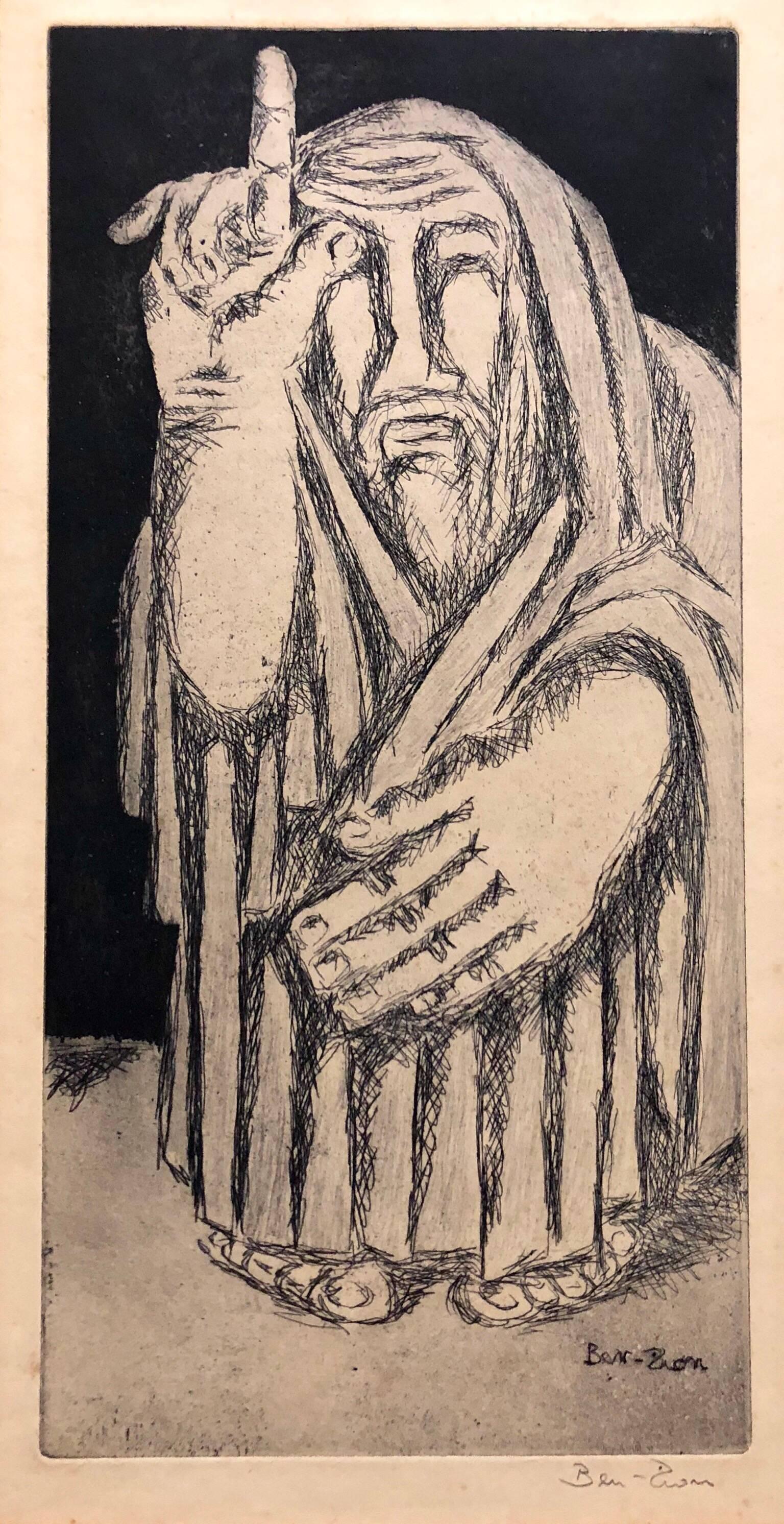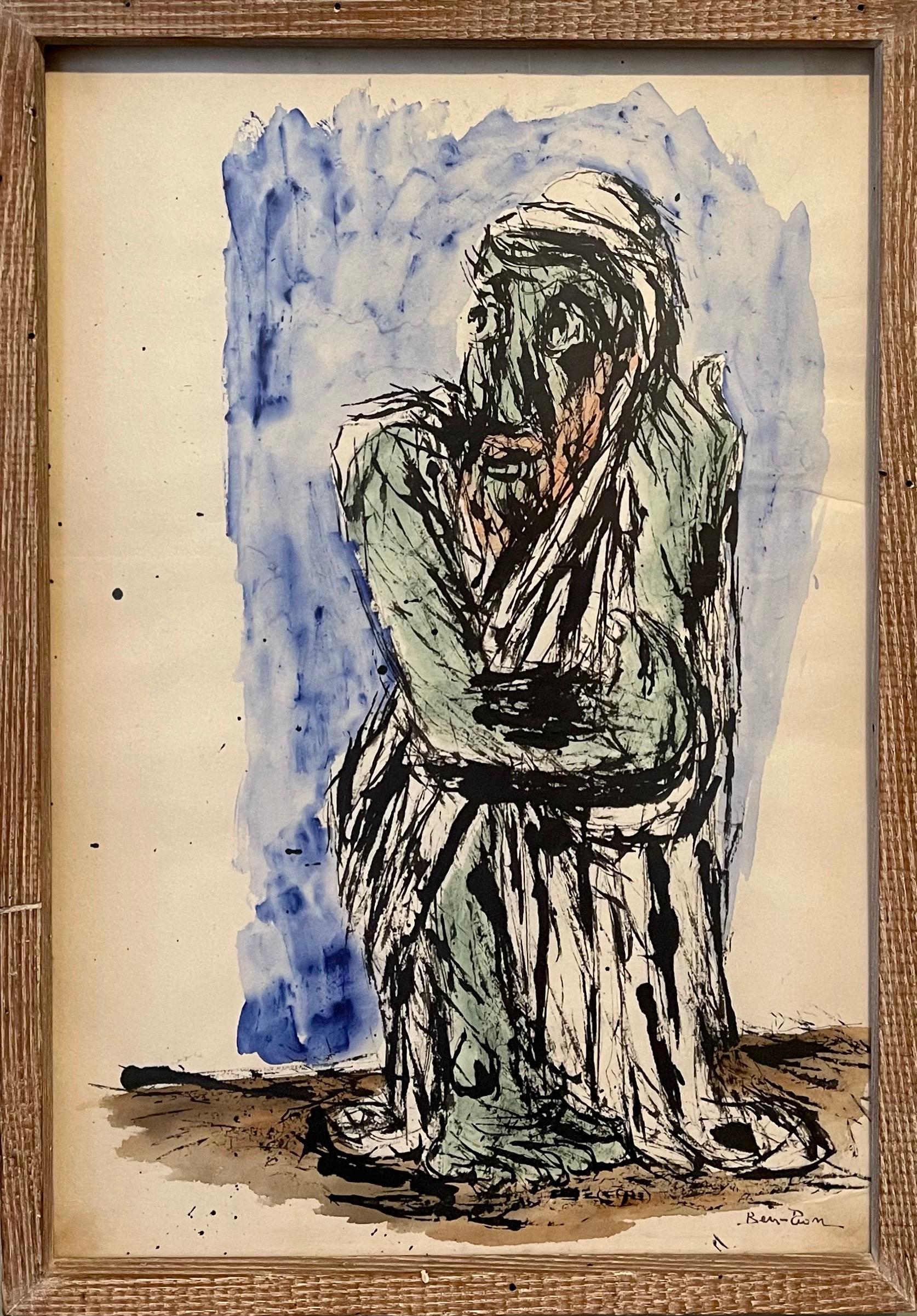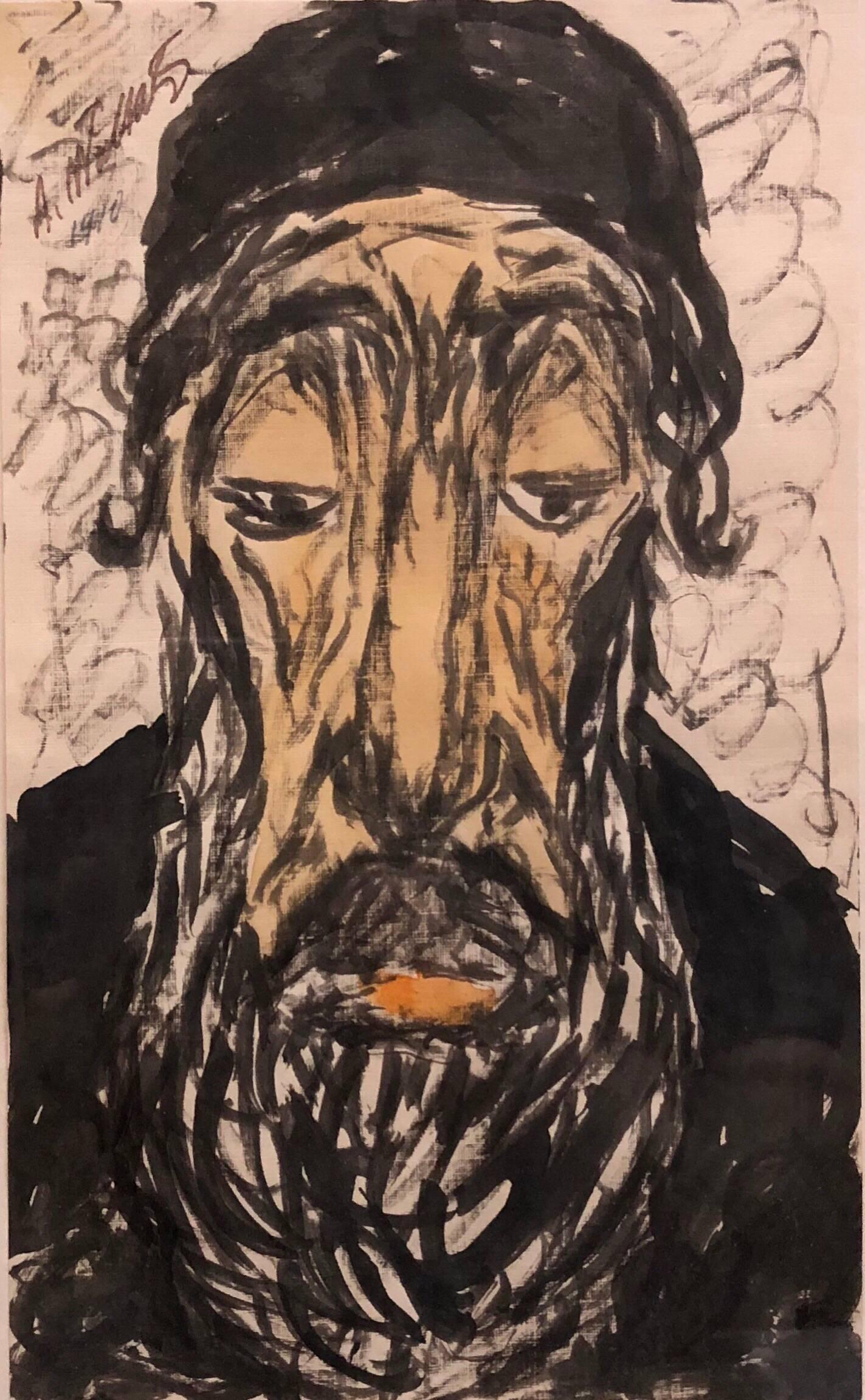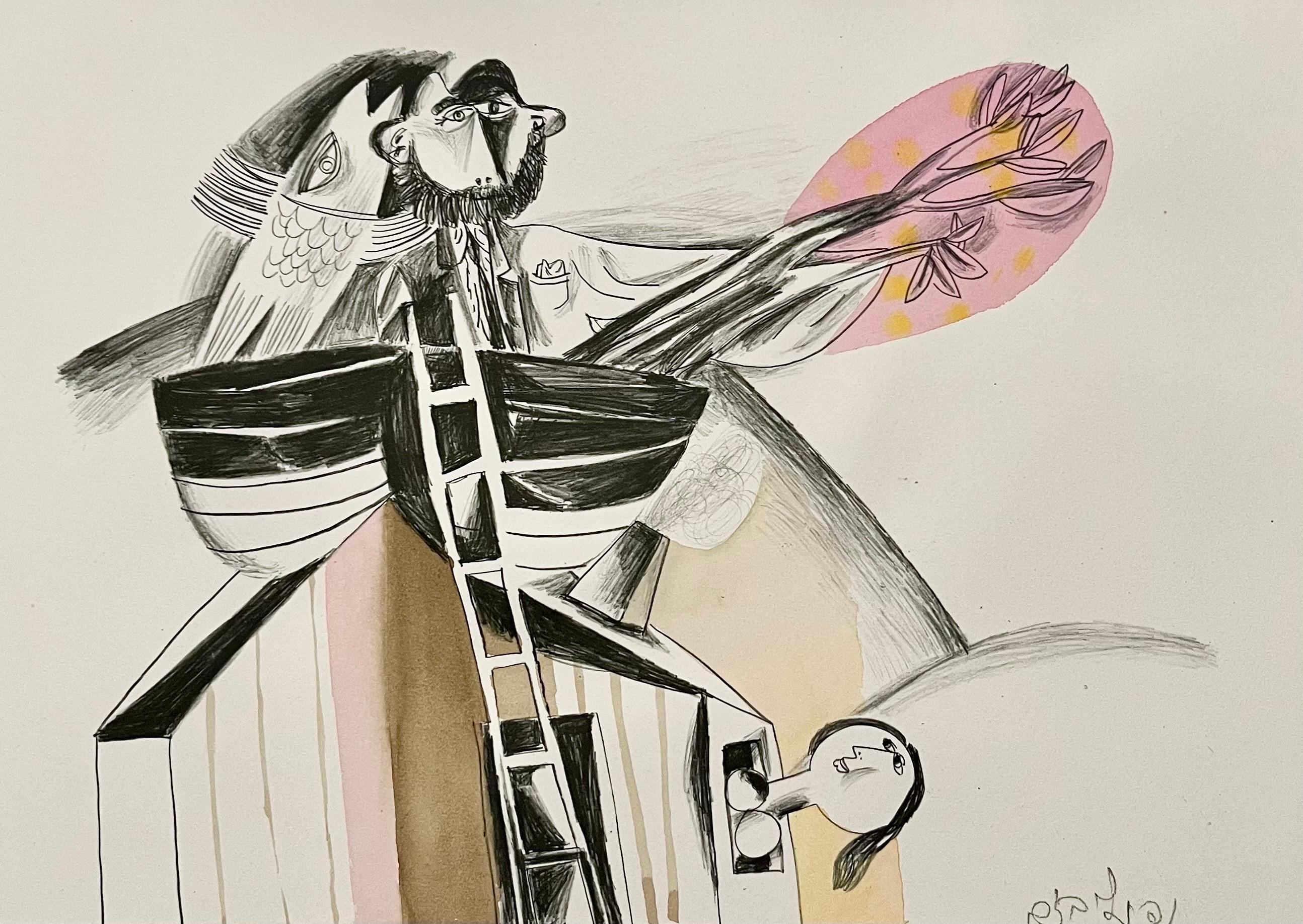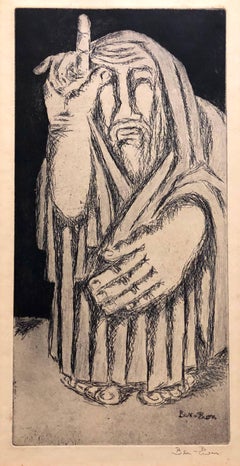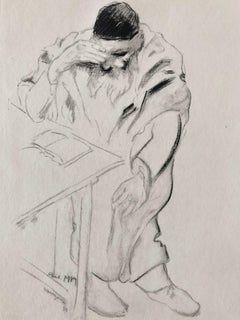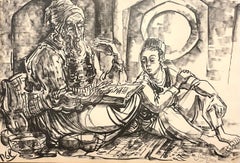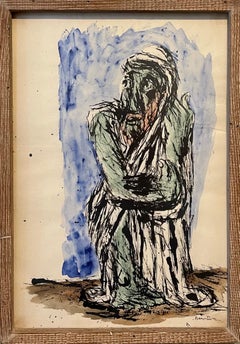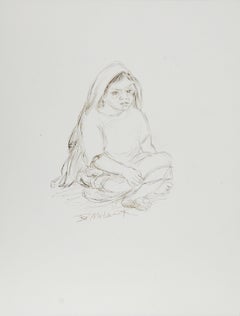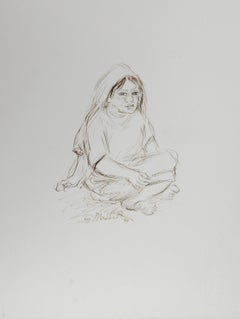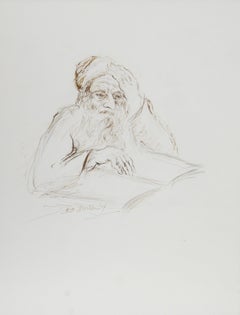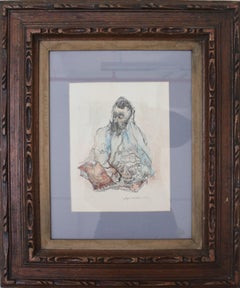Items Similar to Modernist Judaica Jewish Ink Drawing Painting "New Immigrant" Off the Boat WPA
Want more images or videos?
Request additional images or videos from the seller
1 of 8
Ben-Zion WeinmanModernist Judaica Jewish Ink Drawing Painting "New Immigrant" Off the Boat WPAc.1940
c.1940
$1,200
£902.30
€1,047.79
CA$1,675.77
A$1,858.56
CHF 976.02
MX$22,824.42
NOK 12,355.53
SEK 11,651.43
DKK 7,817.69
Shipping
Retrieving quote...The 1stDibs Promise:
Authenticity Guarantee,
Money-Back Guarantee,
24-Hour Cancellation
About the Item
An ink drawing Judaic painting by modern artist Ben-Zion Weinman. It depicts a portrait of an old Jewish man. Coming over from Europe on a ship crossing. The work is signed "Ben-Zion".
Born in 1897, Ben-Zion Weinman celebrated his European Jewish heritage in his visual works as a sculptor, painter, and printmaker. Influenced by Spinoza, Knut Hamsun, and Wladyslaw Reymont, as well as Hebrew literature, Ben-Zion wrote poetry and essays that, like his visual work, attempt to reveal the deep “connection between man and the divine, and between man and earth.”
An emigrant from the Ukraine, he came to the US in 1920. He wrote fairy tales and poems in Hebrew under the name Benzion Weinman, but when he began painting he dropped his last name and hyphenated his first, saying an artist needed only one name. In 1920 he settled in America, where he found little interest in his writing. He began teaching Hebrew to support himself and then in the early 1930s returned to painting. He used his art to comment on the rise of fascism in Europe, events he felt could not be adequately explored with words. Largely self-taught, Ben-Zion visited the museums of New York City to learn his new trade. His first painting on a large scale, Friday Evening (1933, Jewish Museum, New York), depicts a Sabbath dinner table as recalled from his family home. Ben-Zion supported himself by working odd jobs until the establishment of the Works Progress Administration's Federal Art Project. Under the auspices of the wpa, Ben-Zion thrived and galleries began to show his work. In 1936, after his first one-man show at the Artists' Gallery in New York
Ben-Zion was a founding member of “The Ten: An Independent Group” The Ten” a 1930’s avant-garde group, Painted on anything handy. Ben-Zion often used cabinet doors (panels) in his work. Other members of group included Ilya Bolotowsky, Lee Gatch, Adolph Gottlieb, Louis Harris, Yankel Kufeld, Marcus Rothkowitz (later known as Mark Rothko), Louis Schanker, and Joseph Solman. The Art of “The Ten” was generally described as expressionist, as this style offered the best link between modernism and social art. Their exhibition at the Mercury Gallery in New York held at the same time as the Whitney Annual Exhibition of Contemporary American Painting, included a manifesto concentrating on aesthetic questions and criticisms of the conservative definition of modern art imposed by the Whitney. Ben-Zion’s work was quickly noticed. The New York Sun said he painted “furiously” and called him “the farthest along of the lot.” And the triptych, “The Glory of War,” was described by Art News as “resounding.”
By 1939, The Ten disbanded because most of the members found individual galleries to represent their work. Ben-Zion had his first one-man show at the Artist’s Gallery in Greenwich Village and J.B. Neumann, the highly esteemed European art dealer who introduced Paul Klee, (among others) to America, purchased several of Ben-Zion’s drawings. Curt Valentin, another well-known dealer, exhibited groups of his drawings and undertook the printing of four portfolios of etchings, each composed of Ben-Zion’s biblical themes.
Ben-Zion’s work is represented in many museums throughout the country including the Metropolitan, the Whitney, and the Museum of Modern Art in New York, the Art Institute of Chicago, the Philadelphia Museum of Art and the Phillips Collection, Washington. The Jewish Museum in New York opened in 1948 with a Ben-Zion exhibition.
“Ben-Zion has his hands on the pulse of the common man and his natural world”
As he emerged as an artist Ben-Zion never lost his gift for presenting the ordinary in ways that are vital, fresh and filled with emotions that are somber and exhilarating, joyous and thoughtful, and ultimately, filled with extraordinary poetic simplicity.
Ben-Zion consistently threaded certain subject matter—nature, still life, the human figure, the Hebrew Bible, and the Jewish people—into his work throughout his life. "In all his work a profound human feeling remains. Sea and sky, even sheaves of wheat acquire a monolithic beauty and simplicity which delineates the transient as a reflection of the eternal. This sensitive inter- mingling of the physical and metaphysical is one of the most enduring features of Ben-Zion's works." (Excerpt from Stephen Kayser, “Biblical Paintings,” The Jewish Museum Catalogue, 1952).
Ben-Zion continued his style of representational painting based on the abstract, and is perhaps best known for his Biblical paintings and etchings.
Ben-Zion received an American Jewish Congress award.
In 1987, Ben-Zion died in his home in the Chelsea section of Manhattan. He was 90 years old.
- Creator:Ben-Zion Weinman (1897 - 1987, American)
- Creation Year:c.1940
- Dimensions:Height: 14 in (35.56 cm)Width: 12 in (30.48 cm)
- Medium:
- Movement & Style:
- Period:
- Condition:size includes frame. original frame. minor wear to frame.
- Gallery Location:Surfside, FL
- Reference Number:1stDibs: LU38214056662
About the Seller
4.9
Platinum Seller
Premium sellers with a 4.7+ rating and 24-hour response times
Established in 1995
1stDibs seller since 2014
1,780 sales on 1stDibs
Typical response time: <1 hour
- ShippingRetrieving quote...Shipping from: Surfside, FL
- Return Policy
Authenticity Guarantee
In the unlikely event there’s an issue with an item’s authenticity, contact us within 1 year for a full refund. DetailsMoney-Back Guarantee
If your item is not as described, is damaged in transit, or does not arrive, contact us within 7 days for a full refund. Details24-Hour Cancellation
You have a 24-hour grace period in which to reconsider your purchase, with no questions asked.Vetted Professional Sellers
Our world-class sellers must adhere to strict standards for service and quality, maintaining the integrity of our listings.Price-Match Guarantee
If you find that a seller listed the same item for a lower price elsewhere, we’ll match it.Trusted Global Delivery
Our best-in-class carrier network provides specialized shipping options worldwide, including custom delivery.More From This Seller
View AllBiblical Prophet Etching American Modernist WPA Artist
By Ben-Zion Weinman
Located in Surfside, FL
Born in 1897, Ben-Zion Weinman celebrated his European Jewish heritage in his visual works as a sculptor, painter, and printmaker. Influenced by Spinoza, Knut Hamsun, and Wladyslaw Reymont, as well as Hebrew literature, Ben-Zion wrote poetry and essays that, like his visual work, attempt to reveal the deep “connection between man and the divine, and between man and earth.”
An emigrant from the Ukraine, he came to the US in 1920. He wrote fairy tales and poems in Hebrew under the name Benzion Weinman, but when he began painting he dropped his last name and hyphenated his first, saying an artist needed only one name.
Ben-Zion was a founding member of “The Ten: An Independent Group” The Ten” a 1930’s avant-garde group, Painted on anything handy. Ben-Zion often used cabinet...
Category
Mid-20th Century Expressionist Figurative Prints
Materials
Etching
Judaica Jewish Shtetl Etching Hasidic Rabbi "Difficult Problem" Chassidic Print
By Paul Jeffay
Located in Surfside, FL
"Probleme ardu."
Chassidic boy, Yeshiva student with open book. Judaica, Jewish scenes from a ghetto.
Saul Yaffie, a.k.a. Paul Jeffay, (1898–1957) was a Scottish Jewish artist. Know...
Category
20th Century Expressionist Figurative Prints
Materials
Etching
Israeli Jerusalem Judaica Sephardic Rabbi, Boy, Torah Art Drawing Bezalel School
By Jossi Stern
Located in Surfside, FL
Vibrant lithograph by Israeli master JOSSI STERN. on paper mounted to board. Sefardic Rabbi studying with son Torah.
23 x 21 framed 13.5 x 19.5
Hungary, b. 1923, d. 1992
Jossi (Yoss...
Category
20th Century Modern Figurative Prints
Materials
Lithograph
Abstract Expressionist Rabbi Watercolor Painting Jewish American Modernist WPA
By Ben-Zion Weinman
Located in Surfside, FL
Watercolor painting of standing prophet or Rabbi, Judaica artwork
Born in 1897, Ben-Zion Weinman celebrated his European Jewish heritage in his visual works as a sculptor, painter, ...
Category
Mid-20th Century Expressionist Abstract Drawings and Watercolors
Materials
Paper, Watercolor
Modernist Watercolor Painting, Portrait of a Man, the Rabbi
By Abraham Walkowitz
Located in Surfside, FL
Abraham Walkowitz (March 28, 1878 - January 27, 1965) was an American painter grouped in with early American Modernists working in the Modernist style.
Walkowitz was born in Tyumen, Siberia to Jewish parents. He emigrated with his mother to the United States in his early childhood. He studied at the National Academy of Design in New York City and the Académie Julian in Paris under Jean-Paul Laurens. Walkowitz and his contemporaries later gravitated around photographer Alfred Stieglitz's 291 Gallery, originally titled the Little Galleries of the Photo-Secession, where the forerunners of modern art in America gathered and where many European artists were first exhibited in the United States. During the 291 years, Walkowitz worked closely with Stieglitz as well as Arthur Dove, Marsden Hartley, and John Marin (often referred to as "The Stieglitz Quartet").
Early Career and Training
Portrait of Abraham Walkowitz - 1907 - Max Weber - Brooklyn Museum
Walkowitz was drawn to art from childhood. In a 1958 oral interview with Abram Lerner...
Category
Early 20th Century Modern Figurative Drawings and Watercolors
Materials
Paper, Watercolor
Rare Israeli Modernist Judaica Watercolor Painting on Lithograph Naftali Bezem
By Naftali Bezem
Located in Surfside, FL
Naftali Bezem (Hebrew: נפתלי בזם; born November 27, 1924) is an Israeli painter, muralist, and sculptor.
Bezem was born in Essen, Germany, in 1924. His early adolescence was spent ...
Category
1970s Modern Figurative Drawings and Watercolors
Materials
Watercolor, Lithograph
You May Also Like
Child - II, Modern Ink on Paper by Ira Moskowitz
By Ira Moskowitz
Located in Long Island City, NY
Ira Moskowitz, Polish/American (1912 - 2001) - Child - II, Year: circa 1989, Medium: Ink on Paper, signed, Size: 13 in. x 10 in. (33.02 cm x 25.4 cm), Description: Sitting cross-le...
Category
1980s Modern Portrait Drawings and Watercolors
Materials
Ink
Child - I, Modern Ink on Paper by Ira Moskowitz
By Ira Moskowitz
Located in Long Island City, NY
Ira Moskowitz, Polish/American (1912 - 2001) - Child - I, Year: 1989, Medium: Ink on Paper, signed, Size: 13 in. x 10 in. (33.02 cm x 25.4 cm), Description: Sitting cross-legged, th...
Category
1980s Modern Portrait Drawings and Watercolors
Materials
Ink
Rabbi with Book - III, Modern Ink on Paper by Ira Moskowitz
By Ira Moskowitz
Located in Long Island City, NY
Ira Moskowitz, Polish/American (1912 - 2001) - Rabbi with Book - III, Year: circa 1989, Medium: Ink on Paper, signed, Size: 13 in. x 10 in. (33.02 cm x 25.4 cm), Description: Sitti...
Category
1980s Modern Portrait Drawings and Watercolors
Materials
Ink
Untitled (Rabbi Scholar)
By Seymour Rosenthal
Located in New York, NY
Seymour Rosenthal (American 1921-2007) "Untitled: Rabbi Scholar", Figurative Pen/Watercolor on Paper signed in bottom right hand corner, 10.50 x 8 (24 x 20.50 In Frame), Late 20th Ce...
Category
Late 20th Century Abstract Figurative Drawings and Watercolors
Materials
Watercolor, Pen
Rabbi with Student, Folk Art Ink on Paper by Ira Moskowitz
By Ira Moskowitz
Located in Long Island City, NY
Ira Moskowitz, Polish/American (1912 - 2001) - Rabbi with Student, Year: 1989, Medium: Ink on Paper, signed, Size: 13 in. x 10 in. (33.02 cm x 25.4 cm), Description: Reading togeth...
Category
1980s Folk Art Figurative Drawings and Watercolors
Materials
Ink
Figure - Original Ink Drawing - Mid 1900
Located in Roma, IT
Figure is an original drawing in china ink on paper realized by Henri Espinouze. With the stamp of “Atelier H. Espinouze” on the lower right.
The state of preservation is good and a...
Category
Mid-20th Century Contemporary Figurative Drawings and Watercolors
Materials
Ink
More Ways To Browse
Chicago Jewish
Jewish Etching
Modern Judaica Painting
Jewish Ukraine
Used Doors Philadelphia
Wpa Still Life
Paintings Of Old Man And The Sea
Sheaves Of Wheat
Mercury Scale
American Federal Cabinet
Kayser Vintage
Paul Klee Etchings
Ben Harris
Sabbath Art Paintings
Antique Circus Art
Howard Post
Paintings By Perry
Peter Max Painting On Canvas
